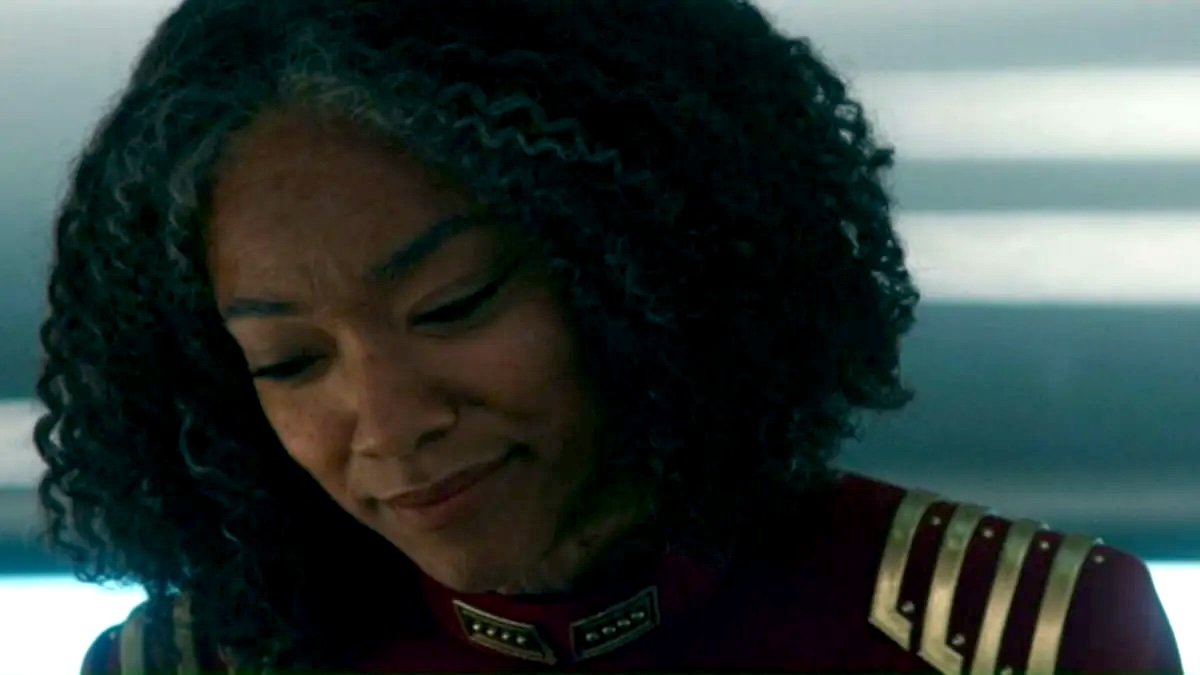‘Star Trek: Discovery’s Finale Finally Explains a Beautiful ‘Short Trek’
"Last time, then. Let's fly." -Admiral Michael Burnham

Star Trek: Discovery not only ushered in a Golden Age of Trek series, but it also spawned a unique series of Trek stories.
Short Treks is a series of short, standalone episodes that illuminate the stories of the full-length series, and Discovery’s recent finale finally addressed the events of one of the very first Short Treks.
** SPOILERS AHEAD for the Discovery finale and the Short Treks episode ‘Calypso.’**
The end of Michael Burnham’s story
The Discovery season finale, “Life, Itself,” shows us what happens to Michael (Sonequa Martin-Green) long after she decides to let go of the Progenitors’ technology and be satisfied with the infinite diversity in infinite combinations that humanoid species have arrived at by the 32nd Century.
In a lovely, 15-minute epilogue (which, according to Memory Alpha, was filmed four months after production wrapped on this episode, once they got word Discovery wasn’t getting another season), we learn that Michael and Book (David Ajala) have grown older together. By the beginning of the 33rd Century, Michael is a Starfleet admiral, and she and Book have a son named Leto (Sawandi Wilson), named after Book’s nephew, whose death particularly traumatized him when Kwejan was destroyed.
Leto is now a Starfleet officer himself, about to assume his first command as a captain, and Michael accompanies him to his new ship. She is also on a new Red Directive mission that involves restoring Discovery to its original configuration.
Alone on the bridge, Michael reminisces about her crew and has one last chat with Zora (voiced by Annabelle Wallis), who will of course remain on Discovery as part of this mysterious mission:
MICHAEL: “I’m going to bring you to a set of coordinates in deep space. Then me and your crew will leave. After that, you wait.”
ZORA: “For what?”
MICHAEL: “This is a Red Directive. We both know how transparent those are. I did hear a word in passing: ‘craft.’ I’m not sure if that’s a person or a vessel, or…”
ZORA: “Well, I’ll find out eventually.”
Star Trek: Discovery, S5 Ep10, ‘Life, Itself’
Yes, she will. And Trek fans who’ve already watched Short Treks already know what “craft” refers to—or rather, to whom.
“Calypso”

The Short Treks episode “Calypso” first dropped on Paramount+ on November 8, 2018, introducing us to Discovery’s AI Zora nearly two years before she’d appear in season three of the show and become a fixture.
In “Calypso,” a human soldier who goes by the name of Craft is in critical condition on an escape pod in deep space when the pod is caught by a tractor beam. Craft next wakes up in sickbay on the USS Discovery, where he’s been rescued and cared for by Zora a thousand years after the events of the show.
Craft has a wife and child to get back to, but having been without any companionship for a millennia, Zora is reluctant to let him leave. She reminds him of the dangers of traveling to his home world from where they are, and encourages him to stay and rest as they chat, play chess, and in a beautiful scene inspired by Zora’s love of old movies, dance (with Zora’s avatar played by Sash Striga).
The episode takes its title from Greek mythology. Calypso is a nymph who rescues Odysseus after a shipwreck in Homer’s Odyssey. She keeps him on her island for seven years so she won’t be alone. However, his sorrow over not seeing his wife is so strong that the gods order Calypso to release him, which she does reluctantly.
As happens in the Homer epic, Zora keeps Craft on Discovery until the depth of his sadness over not being with his wife and child is so apparent that she has no choice but to give him a spacesuit and a shuttle to get him home, so as not to cause him further pain. They have a beautiful goodbye, and even though Craft wants to get home, he is grateful for Zora and loves her in his way.
Zora sends him off in a shuttle she’s named “Funny Face,” after the Fred Astaire/Audrey Hepburn film that inspires their dance.
So, what was the Red Directive?

As Admiral Burnham says in the Discovery finale, “we know how transparent” Red Directives are. That is to say, they aren’t at all. Watching “Calypso” after watching the last episode of Discovery answers some questions, but raises some, too.
We know that for some reason, Zora and Discovery had to wait a thousand years for Craft. He was a known entity. We know that he was a human soldier who stole an enemy (V’draysh) escape pod during a war that raged for ten years.
So, was Zora’s mission to hold onto Craft, or to patch him up and let him go? Was this particular soldier instrumental in ending a war, or keeping one going? What was the Red Directive, and why was Zora waiting for Craft so important?
This last little mystery was the perfect way to end a series whose final season was all about “not having all the answers” and “letting go.” In the end, it doesn’t really matter what the Red Directive was. What matters is that Zora formed a strong connection with the crew of the Discovery, and later formed a beautiful connection with a human named Craft.
With this through-line between Discovery and “Calypso,” the show confirms that moments of connection between beings are enough, living your values and what’s meaningful to you is enough.
“Life, Itself” is enough.
Have a tip we should know? [email protected]